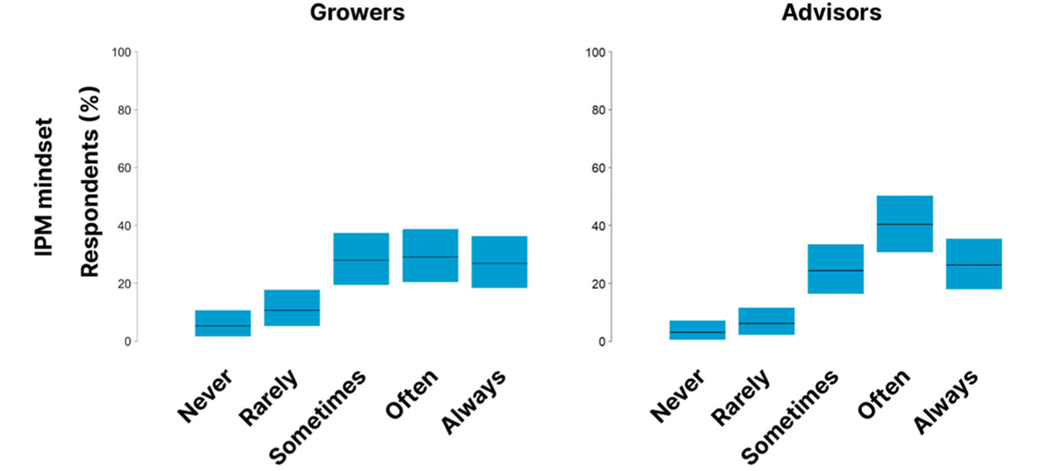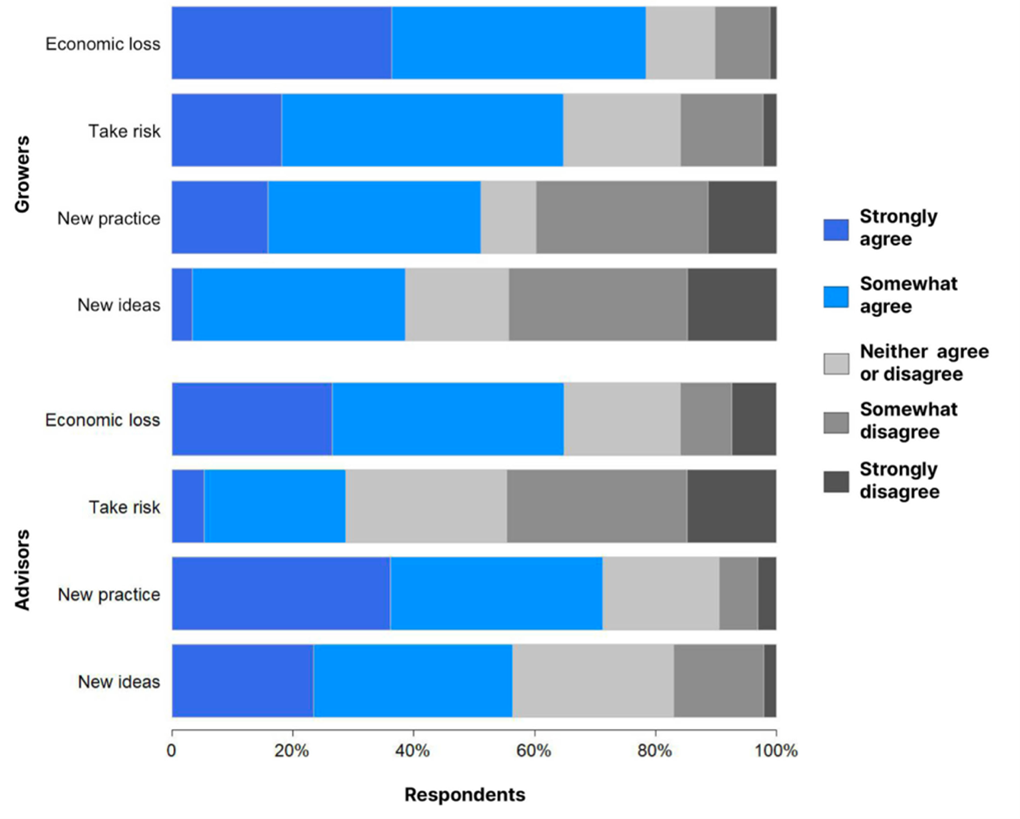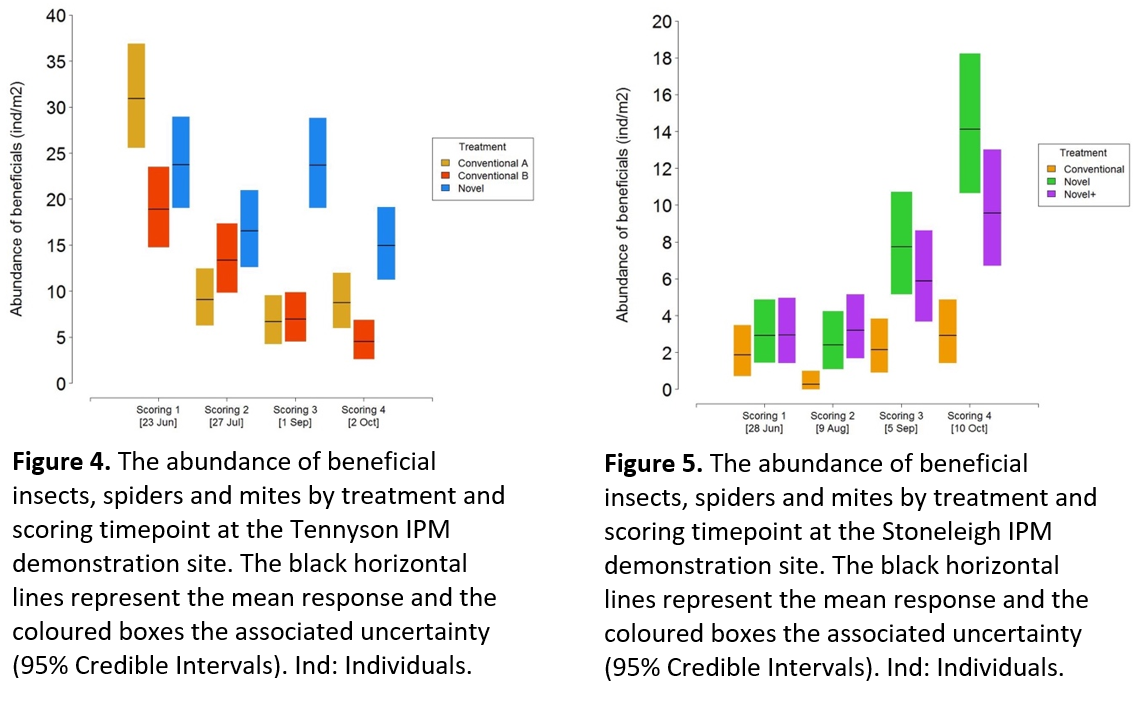Using resistance surveillance, IPM demonstrations and social benchmarking to improve redlegged earth mite management
Author: Adriana Arturi, Luis Mata, Aston Arthur, Paul Umina, James Maino, Lizzy Lowe(Cesar Australia, Melbourne, Victoria), Svetlana Micic, Alan Lord (Department of Department of Primary Industries and Regional Development, Western Australia) | Date: 07 Feb 2023
Take home messages
- Due to evolving resistance in the redlegged earth mite, there is a need to reduce reliance on current insecticides and rethink management options for this pest.
- Detections of populations of RLEM resistant to SPs and OPs continue to increase, with the known range expanding, particularly in eastern Australia.
- Growers can keep RLEM under economic thresholds with minimum insecticides and preserve higher densities of beneficials.
- Social benchmarking has identified attitudes towards insecticides and IPM, and showed that that agronomists can be more risk adverse than growers.
Background
The redlegged earth mite (Halotydeus destructor, RLEM) is a destructive, and economically important pest in Australia’s grain and pasture crops. The repeated use of limited chemical control options for RLEM has resulted in resistance issues across large areas of Western Australia and parts of south-eastern Australia. Many RLEM populations in these areas are resistant to synthetic pyrethroids (SPs), organophosphates (OPs), or both. This rise in resistance demonstrates a need to change the way insecticides are used to minimise the risk of further resistance in RLEM. In grain and pasture regions affected by this pest, resistance surveillance and the development of up-to-date management recommendations help to maintain the effectiveness of current chemical control options. Integrated pest management (IPM) strategies provide alternatives to insecticide use and support growers' efforts to manage insecticide resistance. Social research develops our understanding of current knowledge and attitudes regarding insecticide resistance management. These insights are used to ensure that management recommendations are applicable and achievable.
In this presentation, we will:
- present data on the current resistance status of RLEM in Australia
- showcase results from the project’s IPM demonstration sites
- present and discuss the project’s social benchmarking research, and
- provide recommendations about insecticide resistance management and improved control methods to help growers and advisors stay on top of RLEM pest problems this year.
Field surveys and resistance testing
Since the first detection of SP resistance in RLEM in 2006, resistance surveillance has been undertaken every year, covering a wide geographical range throughout Western Australia and eastern Australia (including SA, Victoria, and New South Wales). RLEM populations collected for the resistance screening have been mostly collected from a mixture of paddocks with reported chemical control failures and paddocks with high insecticide and intensive cropping usage, with some indiscriminate collections also undertaken from paddocks and roadside vegetation. Samples of mites from each population have been screened for SP and OP resistance using phenotypic laboratory bio-assays (Arthur et al. 2021) and/or genetic markers targeting the known resistance mechanism to SPs (Edwards et al. 2018).
Following the screening, growers and advisors have been provided with a full report outlining the type of resistance present on their farms. The report is accompanied by management recommendations that are specific to the type of resistance present. Using this information, growers can minimise RLEM chemical control failures and the evolution and spread of insecticide resistance. More broadly, the surveillance and mapping of RLEM resistance provide important information that assists growers to implement successful management strategies to minimise the impact of RLEM. Resistance surveillance information is also used to update the RLEM Resistance Management Strategy (RMS).
IPM demonstration sites 2022
On-farm trials were established to demonstrate IPM approaches and novel control strategies, that is, reduced insecticide applications for RLEM control. These demonstration sites help to make the research findings available to Australian grain growers to support the widespread adoption of IPM for RLEM control. The IPM demonstration sites are in Stoneleigh and Tennyson (Victoria). Both sites compare conventional farming practices to more novel farming approaches and the effect they have on RLEM abundance, predatory mites, and other beneficial invertebrates.
Stoneleigh was sown with wheat for the 2022 growing season. Here, the three different management scenarios were composed of two novel management plots – ‘Novel’ and ‘Novel+’ – and a ‘Conventional’ plot, all of which were ~10ha. The Novel plot is how the rest of the paddock has been traditionally managed by the grower. The additional Novel+ examined the effect of no fungicide applications. All plots received the same fertiliser treatments.
At the Tennyson site, the paddock was also sown with wheat for the 2022 growing season. This site compares RLEM abundance with conventional farm management practices with a novel approach that uses few chemicals and improves crop health and soil nutrition by adding biological inputs such as vermicast extracts, fulvic powder, and biofertilisers. In the 2022 season, three management scenarios were demonstrated: two conventionally managed plots and one novel plot, all of which were ~10ha.
Within the plots at each site, 15 observations were made at four times throughout the growing season. Each observation point was a 50cm x 50cm quadrant which was sampled for mites and other invertebrates using a Stihl vacuum blower with a fine mesh over the end of the suction tube. RLEM and other invertebrates were counted. Plots were harvested at the end of the cropping season and yield data will be used to conduct a cost-benefit analysis to compare the profitability of the different treatments.
Social benchmarking
Using a national online survey, we investigated the current knowledge, practices, and attitudes of growers and advisors relating to RLEM insecticide resistance management. We aimed to understand how chemical-based management of RLEM is influenced by variables such as risk attitude, risk perception and knowledge. The findings provide information on current barriers to the adoption of sustainable management practices in different sub-populations and will inform the development of improved training and awareness outputs.
The survey was 24 questions long and was divided into the following categories:
- demographics
- insecticide use patterns
- attitude towards risk in their management practice/advice
- knowledge of RLEM and insecticide resistance, and
- connectivity in their community.
Both growers and advisors were asked a range of questions about their chemical usage, attitude to risk about pest management, knowledge of the RLEM resistance status, ability to correctly identify the mite, and lifecycle, and estimate the number of non-chemical options available.
Results and discussion
Field surveys and resistance testing
Resistant RLEM populations have been found across Western Australia, South Australia, and Victoria since resistance surveillance began in 2006. Screening undertaken between 2006 and 2022 found SP resistance to be widespread across the southern regions of WA and in some parts of South Australia (Arthur et al. 2021). OP resistance has been detected in the southern regions of Western Australia and parts of South Australia and Victoria.
Within WA, the current distribution of SP and OP resistance is widespread, covering the southwest, great southern, south coastal and wheatbelt regions (Figure 1). Resistance in RLEM appears to be increasing in WA, with new resistant populations being detected each year. For example, RLEM resistance to OPs has only just been detected for the first time last year in the southern coastal regions of WA (Mata et al. 2022).
Over the last few years, we have seen a major increase in RLEM insecticide resistance in eastern Australia, particularly within South Australia. In South Australia, resistance was first discovered in 2016, and since then, resistance has been detected in several areas including Kangaroo Island, the Fleurieu Peninsula, and the south-east region (Figure 1). Over the last couple of years, there has been an increase in resistant populations to SPs and OPs in these areas, particularly in the south-east region. More recently, resistant populations have been detected in the mid-north region.
Resistance in Victoria was first detected in 2018 to OPs, in Wanalta in north central Victoria (Arthur et al. 2021). Since then, several OP resistant populations have been detected in Victoria in the north central region and in Minimay in the Wimmera region. There has been no SP resistance detected within Victoria to date.

Figure 1. Current resistance status of RLEM resistance in Australia as of 2022 to OPs and SPs.
IPM demonstration sites
Across both demonstration sites, unsurprisingly, our findings show that an SP foliar application greatlyreduced RLEM numbers when applied to the conventional plots (Figures 2 and 3). Importantly, in the plots that did not receive an insecticide spray application, RLEM remained well below the economic thresholds for wheat. The economic threshold for wheat is 5 000 mites per m2 (Miles 1996). Although the trials are still in their infancy, these initial findings suggest that the current IPM management strategies being employed at each site provide a level of natural suppression against RLEM. Yield data and cost-benefit analysis for the 2022 growing season are yet to be analysed.
Our analyses also indicate that the foliar SP application had a negative effect on predatory snout mites and other beneficial invertebrates. In the conventional plots at the Tennyson site, beneficial abundances steadily declined over the season (Figure 4). This suggests the insecticide had a lasting impact on the populations of beneficial species. At the Stoneleigh site, populations of snout mites and other beneficials built up over the season in both novel plots, but not in the conventionalplot (Fig. 5).
Social benchmarking
A total of 273 responses were received. When partial and invalid responses were removed (for example, had not encountered RLEM before or did not work as a grower or advisor in Australia), this resulted in 93 responses from growers and 97 responses from advisors. When growers were asked how often they apply foliar insecticides specifically for control of RLEM, 5% answered several times a season, 35% every year, 25% once every 2–3 years, 9% once every 4–5 years, 14% rarely (once in 10 years), 11% never and 1% unsure. In relation to the use of IPM, Figure 6 shows how often respondents reported they employ an IPM mindset. When making RLEM management decisions, 72% of growers consider environmental factors and 77% consider paddock history. For advisors giving management support, 81% consider environmental factors and 88% consider paddock history. There were very few respondents who self-reported never having an IPM mindset. Responses to risk questions can be seen in Figure 7. One observation from these results is that growers are more worried about economic loss, but advisors are much more cautious about adopting new practices and wanting to see the results from farm trials before trying practices on their farms.

Figure 6. Growers (left) and advisors (right) responses when asked how often they employ an IPM mindset when making RLEM management decisions or providing advice. The black horizontal lines represent the mean response and the blue boxes the associated uncertainty (95% confidence Intervals).

Figure 7. Growers (top) and advisors (bottom) responses to questions related to risk in on- farm pest management. The following abbreviations were used for each survey question:Economic loss - I am concerned about economic loss as a result of invertebrate pest damage; Take risk - I am willing to take risks when it comes to farming; New ideas - I am cautious about adopting new ideas and farm practices; New practice - A new farm practice must be proven on other farms or trials before I will use it.
Conclusions
The ongoing surveillance of RLEM provides growers with insight into the resistance status in their region, which can inform management decisions. In areas with high levels of resistance or risk of resistance, growers and advisors can use the RLEM RMS to inform their management practice. Key recommendations for RLEM control include:
- assess RLEM populations over successive checks to determine if chemical control is warranted
- do not use the same chemical group across successive spray windows (on multiple generations of mites) as this will select for resistance to that chemical group
- co-formulations or chemical mixtures are best reserved for situations where damaging levels of RLEM and other pest species are present, and a single active ingredient is unlikely to provide adequate control
- consider the impact on target and non-target pests and beneficial invertebrates when applying insecticide sprays. Where possible, use target-specific ‘soft’ chemicals, especially in paddocks with resistant RLEM
- if you experience a chemical control failure involving RLEM and/or suspect insecticide resistance, contact DPIRD (WA) or Cesar Australia (SA, Vic, NSW) who can assist with advice and/or resistance testing.
The social research enables us to better understand motives and identify knowledge gaps, which will be used to produce regionally relevant management recommendations and extension materials which address the concerns of growers to help increase the adoption of IPM practice.
Acknowledgements
The research undertaken as part of this project is made possible by the significant contributions of growers through both trial cooperation and the support of the GRDC, the authors would like to thank them for their continued support.
The RLEM project (CES2010-001RXT) is being undertaken in collaboration with the University of Melbourne, WA Department of Primary Industries and Regional Development (DPIRD) and James Ridsdill-Smith with funding from Grains Research and Development Corporation (GRDC). We would like to acknowledge Leo McGrane for his earlier work on this project.
The authors thank the many agronomists and growers who aided in mite collections, helped with field sites and provided field history information. The authors thank Lisa Kirkland,
Josh Douglas, Olivia Reynolds, Jenny Reidy-Crofts, Xuan Cheng, Matt Binns, Peter Mangano, Nick Bell, Clay Sutton, Thomas Heddle, Isobel Roberts, Tiana Rey and Paul Tyson for technical input and assisting with field collections. Thanks also to Amol Ghodke, Anthony van Rooyen, Moshe Jasper, Haylo Roberts, and Andrew Weeks for assisting with the molecular analysis of pyrethroid resistance.
References
Arthur AL, Maino J, Hoffmann AA, Jasper M, Lord A, Micic S, Edwards O, van Rooyen A, Umina PA (2021) Learnings from over a decade of increasing pesticide resistance in the redlegged earth mite, Halotydeus destructor (Tucker). Pest Management Science 77, 3013-3024.
Edwards OR, Walsh TK, Metcalfe S, Tay WT, Hoffmann AA, Mangano P, Lord A, Micic S, Umina PA (2018) A genomic approach to identify and monitor a novel pyrethroid resistance mutation in the redlegged earth mite, Halotydeus destructor. Pesticide Biochemistry and Physiology 144, 83-90.
Mata L, Arturi A, Weeks A, Anthony V, Arthur A, Maino J, Lowe L, Umina P, Hoffmann A, MacMahon A, Kang H, Carew M, Yang Q, Pavri, Ridsdill-Smith J, Lord A, Micic S (2022) Future options for the control of RLEM in Australian grain crops – annual progress report 2022.
Miles M (1996) Control threshold and sampling recommendations for insect pests of field crops and pastures. Victorian Institute for Dryland Agriculture, Horsham VIC.
Resistance management strategy for the Redlegged Earth Mite in Australian grains and pastures
Redlegged earth mite best management practice guide – southern
Free RLEM insecticide resistance testing
Contact details
Luis Mata
+61 3 9349 4723
lmata@cesaraustralia.com
Svetlana Micic
+61 9892 8591
svetlana.micic@dpird.wa.gov.au
GRDC Project Code: CES2010-001RTX,
Was this page helpful?
YOUR FEEDBACK


